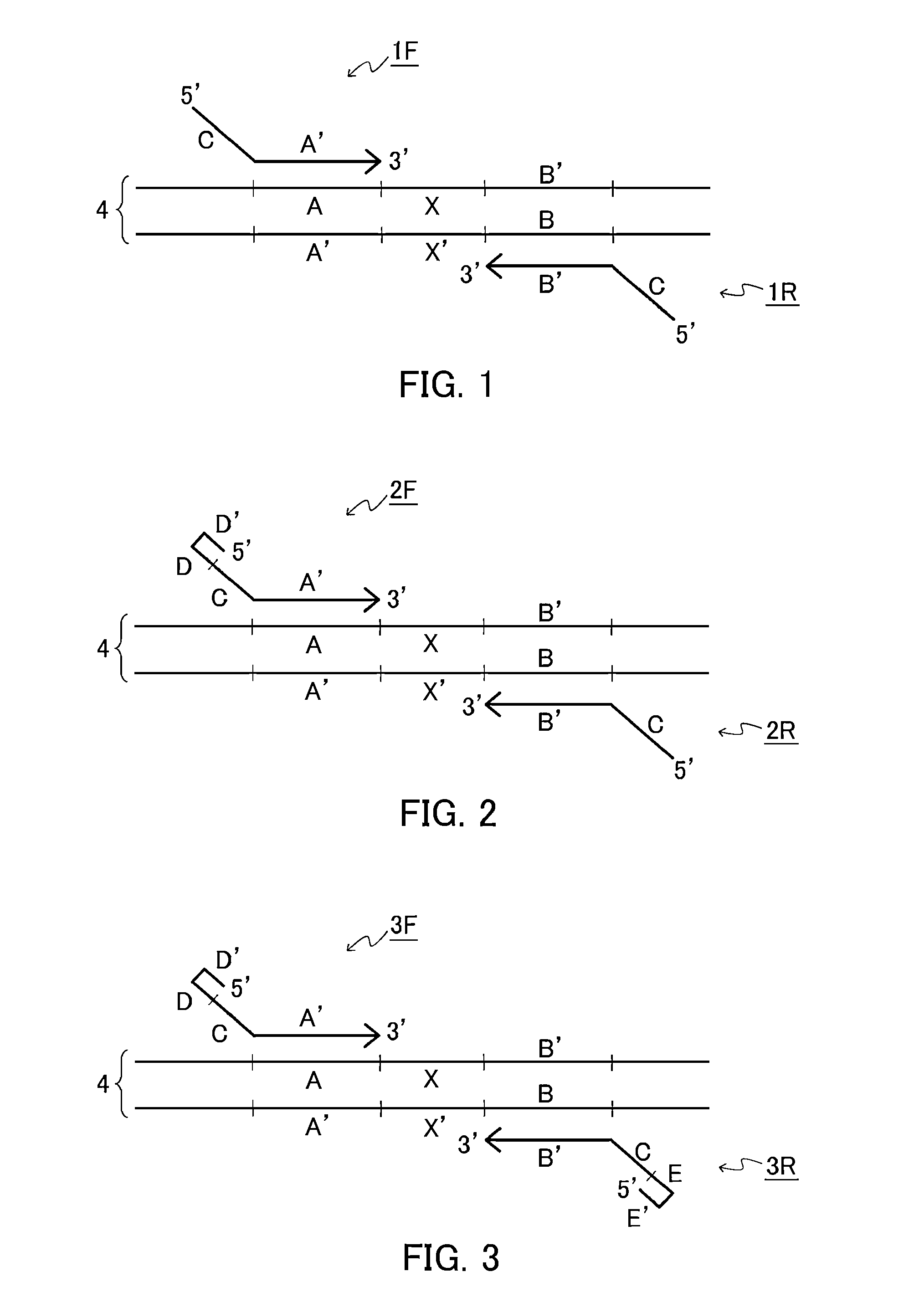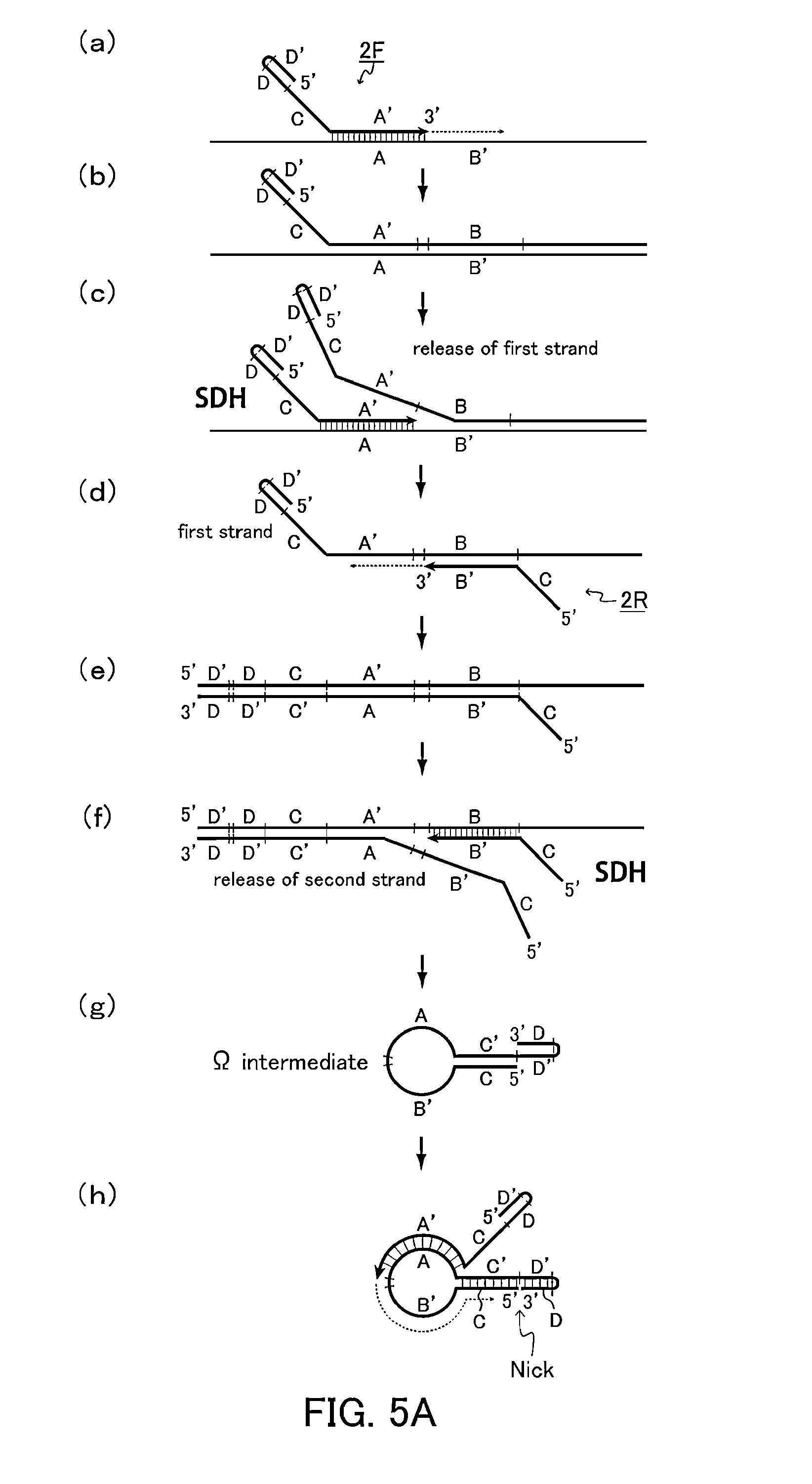Primer set, method for amplifying target nucleic acid sequence using same, and method for detecting mutated nucleic acid using same
a target nucleic acid and primer technology, applied in the field of primer sets, can solve the problems of difficult shortening of the sequence of the region to be amplified in the target nucleic acid sequence, the inability to detect it easily, and the high cost of thermal cyclers, so as to achieve the effect of easy primer design and shortening of the sequence of the region to be amplified
- Summary
- Abstract
- Description
- Claims
- Application Information
AI Technical Summary
Benefits of technology
Problems solved by technology
Method used
Image
Examples
example 1
[0167]In the present example, a target nucleic acid sequence was amplified isothermally using the following two kinds of primer sets: a primer set configured so that either one of a first primer and a second primer includes a folding sequence (D-D′); and a primer set configured so that a first primer includes a folding sequence (D-D′) and a second primer includes a folding sequence (E-E′).
[0168]A reaction solution was prepared by adding a forward primer having the following sequence (Forward Primer 1: SEQ ID NO: 1 or Forward Primer 2: SEQ ID NO: 2) and a reverse primer having the following sequence (Reverse Primer 1: SEQ ID NO: 3, or Reverse Primer 2:SEQ ID NO: 4) so that the concentration of each primer was 2 μM to a solution with a volume of 25 μL containing the following components with the following final concentrations: 1.4 mM dNTP, 5% DMSO, 20 mM Tris-HCl (pH 8.0), 30 mM potassium acetate, 10 mM sodium sulfate, 8 mM magnesium sulfate, 0.1% Tween 20, 1 / 100000 dilution of SYBR G...
example 2
[0175]In the present example, a target nucleic acid sequence was amplified isothermally using a primer set configured so that a first primer and a second primer each includes an intervening sequence (H) inserted between a folding sequence (D-D′) or (E-E′) and a common sequence (C). The intervening sequence (H) in the first primer was different from the intervening sequence (H) in the second primer.
[0176]The reaction solution in the present example had the same composition as the reaction solution in Example 1, except for the primers. Specifically, the reaction solution was prepared by adding a forward primer having the following sequence (Forward Primer 3: SEQ ID NO: 6) and a reverse primer having the following sequence (Reverse Primer 3: SEQ ID NO: 7) so that the concentration of each primer was 2 μM to a solution with a volume of 25 μL containing the following components with the following final concentrations: 1.4 mM dNTP, 5% DMSO, 20 mM Tris-HCl (pH 8.0), 30 mM potassium acetate...
example 3
Effect of a Third Primer
[0180]The present example examined whether a third primer designed so as to be complementary to a region between anneal regions of a first primer and a second primer anneal in a target nucleic acid exhibits an effect of improving an isothermal amplification reaction in the present invention.
[0181]First, in the present example, first and second primers each including an intervening sequence (H) inserted between a folding sequence (D-D′) or (E-E′) and a common sequence (C) were used. The reaction solution in the present example had the same composition as the reaction solution in Example 1, except for the primers. Specifically, the reaction solution excluding the primer was a solution with a volume of 25 μL containing the following components with the following final concentrations: 1.4 mM dNTP, 5% DMSO, 20 mM Tris-HCl (pH 8.0), 30 mM potassium acetate, 10 mM sodium sulfate, 8 mM magnesium sulfate, 0.1% Tween 20, 1 / 100000 dilution of SYBR Green I (Takara Shuzo ...
PUM
| Property | Measurement | Unit |
|---|---|---|
| temperature | aaaaa | aaaaa |
| temperature | aaaaa | aaaaa |
| temperature | aaaaa | aaaaa |
Abstract
Description
Claims
Application Information
 Login to View More
Login to View More - R&D
- Intellectual Property
- Life Sciences
- Materials
- Tech Scout
- Unparalleled Data Quality
- Higher Quality Content
- 60% Fewer Hallucinations
Browse by: Latest US Patents, China's latest patents, Technical Efficacy Thesaurus, Application Domain, Technology Topic, Popular Technical Reports.
© 2025 PatSnap. All rights reserved.Legal|Privacy policy|Modern Slavery Act Transparency Statement|Sitemap|About US| Contact US: help@patsnap.com



